Have you traveled through Arkansas, marveling at the stunning scenery while making memories that will last a lifetime? While you can’t forget the beauty of its mountains, lakes, and rivers, most tourists overlook some of the ancient wonders that lie within its borders: wonderful trees that have been living for centuries.
From grand old oaks to pine, Arkansas is home to many remarkable trees. These ancient monuments of nature are works of art in themselves, providing an instant connection with the past and reminding us how nature shapes our lives.
Arkansas is known for its rich biodiversity, with many different species of native trees. These trees are often found in dense forests and open woodlands, from deciduous hardwoods to evergreens. Furthermore, they play a vital role in the ecosystem and provide animal habitats, building materials, and food sources for wildlife.
In this article, we will discuss seven incredible native trees in Arkansas. You should consider them if you’re looking for shade or adding an interesting adornment to your landscape.
1. Pine Tree
Overall, pine trees in Arkansas are an iconic part of the landscape, known for their strength, resilience, and natural beauty. They are a sight to behold, especially during fall and winter, when their evergreen needles contrast with the colors of the changing leaves. They are also Arkansas’s official state tree!
Appearance
Pine trees in Arkansas are tall and stately, with a distinct conical shape and an evergreen canopy of needle-like leaves. Their bark is typically rough and scaly, with a reddish-brown color that deepens with age. The pine tree’s needles are long and slender, ranging from dark green to blue-green. Depending on the species, they grow in clusters and can be anywhere from 2-5 inches long.
The crown of a pine tree consists of long branches that extend outwards, creating a wide and full silhouette. In addition, the branches consist of small, woody cones that give the tree a rustic and natural appearance.
When the wind blows, the needles of the pine tree sway and rustle, making a soothing sound reminiscent of a gentle breeze. The pine tree’s scent is also notable, as it exudes a woodsy and fresh aroma often associated with the outdoors.
The most common pine trees in Arkansas are loblolly and shortleaf yellow.
Why Native Pine Trees Are Valuable?
Native pine trees in Arkansas are valuable for several reasons.
- Timber: Pine trees are a primary source of timber in Arkansas. They are used to make various products, including lumber, paper, and plywood. In addition, the southern yellow pine species gets used in construction, flooring, and furniture.
- Ecosystem services: Pine trees play an essential role in the ecosystem by providing habitat for wildlife, improving water and air quality, and reducing soil erosion. Pine forests are known for their high biodiversity and support a variety of plant and animal species.
- Recreational value: Pine forests are popular for outdoor activities such as hiking, camping, hunting, and bird watching. They also provide scenic views and aesthetic benefits to the landscape.
- Carbon sequestration: Pine forests help to sequester carbon from the atmosphere, which is an important benefit for mitigating the effects of climate change.
- Economic value: Pine forests provide jobs and income for people in the forestry, timber, and wood products industries. They also generate income from recreation and tourism.
It’s also important to note that different species of pine trees may have slightly different characteristics and uses, so the specific reasons for growing pine trees in Arkansas may vary depending on the species being grown.
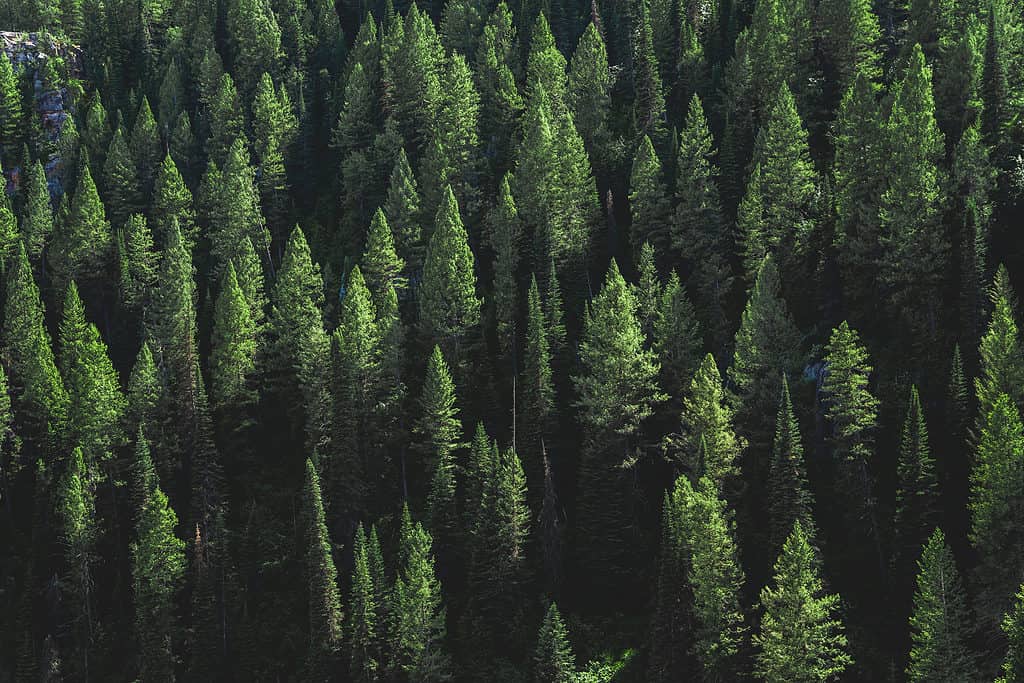
The pine tree’s (pictured) scent is also notable, as it exudes a woodsy and fresh aroma.
©iStock.com/Clark Ahlstrom
2. Red Buckeye
The red buckeye (Aesculus pavia) is a deciduous tree or shrub native to Arkansas and other southeastern United States. It typically grows between 15-20 feet tall, although it can reach up to 30 feet in ideal conditions.
The red buckeye has a broad and rounded shape with a dense canopy of green leaves. The leaves are typically palmately compound, with 5-7 leaflets arranged in a circular pattern around a central stem. The leaflets are oval or oblong and have a glossy green color on top and a slightly paler color on the bottom.
In spring, the red buckeye produces large bunches of showy, bright red or orange-red flowers that bloom along the branches before the leaves appear. The tubular flowers have a distinctive, nectar-rich aroma that attracts hummingbirds and other pollinators.
In fall, the leaves of the red buckeye turn yellow or golden brown before falling off the tree. The bark of the red buckeye is flaky and gray, but as it matures, it can become slightly furrowed and darken to a dark gray. The red buckeye is an excellent ornamental tree for gardens and landscapes because of its showy flowers and attractive shape. In addition, it can tolerate a wide range of soil conditions and is drought-tolerant.
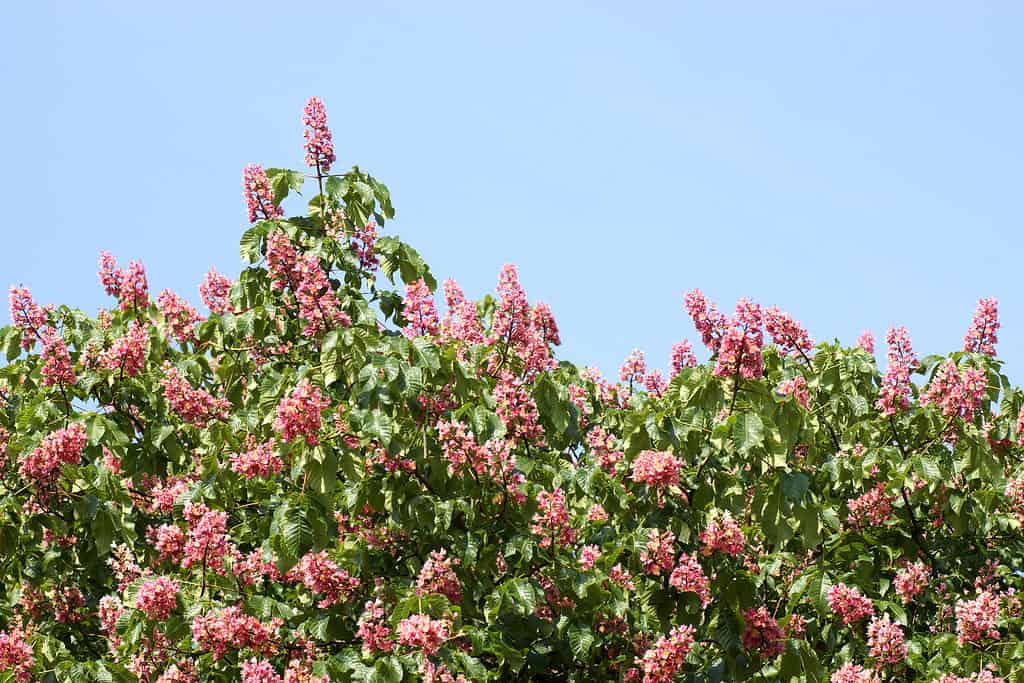
Red buckeye (pictured) puts on a beautiful display of blooming red flowers in the spring.
©Bildagentur Zoonar GmbH/Shutterstock.com
3. Eastern Hop-Hornbeam
The Eastern hop-hornbeam (Ostrya virginiana) is a deciduous tree native to the eastern United States, including Arkansas. It typically grows between 25-30 feet tall, with a narrow and upright shape. The Eastern hop-hornbeam has a smooth, grayish-brown bark that becomes deeply furrowed and scaly as it matures. The branches are slender and twiggy, with a zigzag pattern that gives the tree a unique and interesting silhouette.
The leaves of the Eastern hop-hornbeam are simple and ovate, with a bright green color and a fine, serrated margin. They are typically 2-4 inches long and are arranged alternately on the branches. The leaves turn yellow in fall, adding a pop of color to the landscape before falling off the tree.
In early spring, the Eastern hop-hornbeam produces small, inconspicuous greenish-yellow flowers arranged in drooping clusters. In addition, they have small, green, hop-like fruit that matures to a light brown color that dangles from the tree giving it its common name.
The Eastern hop-hornbeam is a great tree for adding texture and interest to landscapes. It’s a hardy tree that can tolerate a wide range of soil conditions and is a good choice for smaller landscapes and planting under power lines. It’s also a good tree for wildlife, providing food and shelter for birds and other small animals.
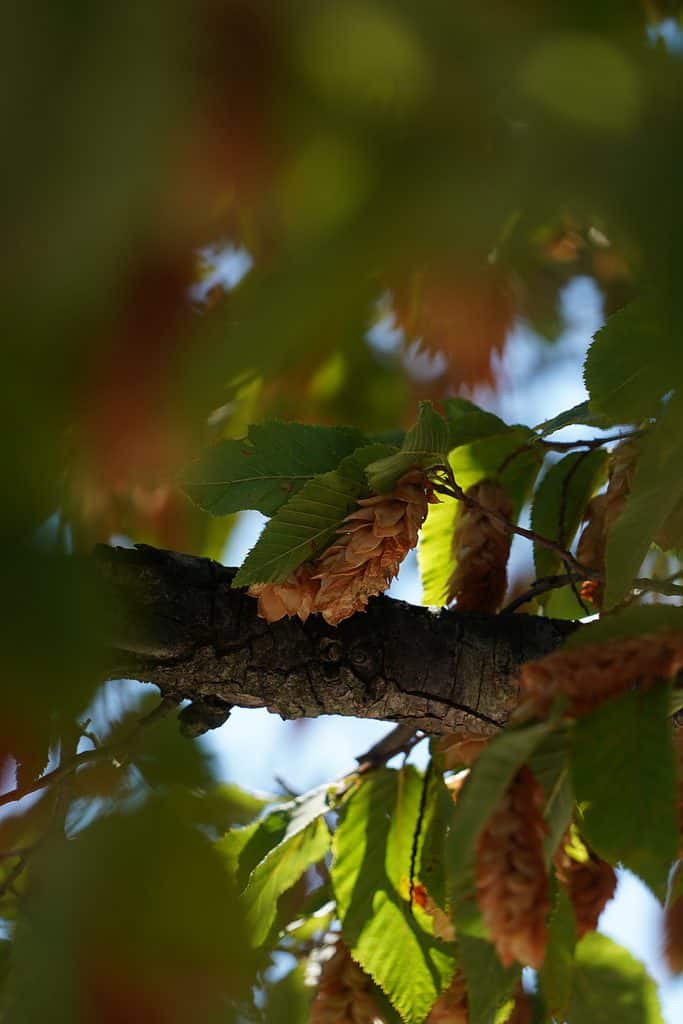
Eastern Hop-Hornbeam (pictured) is a hardy tree that can withstand a range of weather conditions and thrive.
©iStock.com/Wirestock
4. Red Mulberry
The red mulberry (Morus rubra) is a deciduous tree native to the eastern United States, including Arkansas. It typically grows between 30-50 feet tall, with a broad and spreading canopy. The red mulberry has a rough and deeply furrowed bark that is dark gray or black in color. The branches are thick, with a slightly drooping habit that gives the tree a relaxed and natural appearance.
The leaves of the red mulberry are simple and lobed, with a glossy green color and a slightly serrated margin. They are typically 4-8 inches long and are arranged alternately on the branches. The leaves turn yellow in fall, adding a splash of color to the landscape before falling off the tree.
The red mulberry produces small, greenish-white flowers arranged in drooping clusters in early spring. These are followed by small, dark red to black berries that are edible, juicy, and sweet. The red mulberry is great for adding character and interest to gardens and landscapes. It’s a hardy tree that tolerates a wide range of soil conditions and grows in both sun and shade. They are a popular food source for birds, raccoons, and other wildlife. The fruit is also edible and enjoyed by many people.
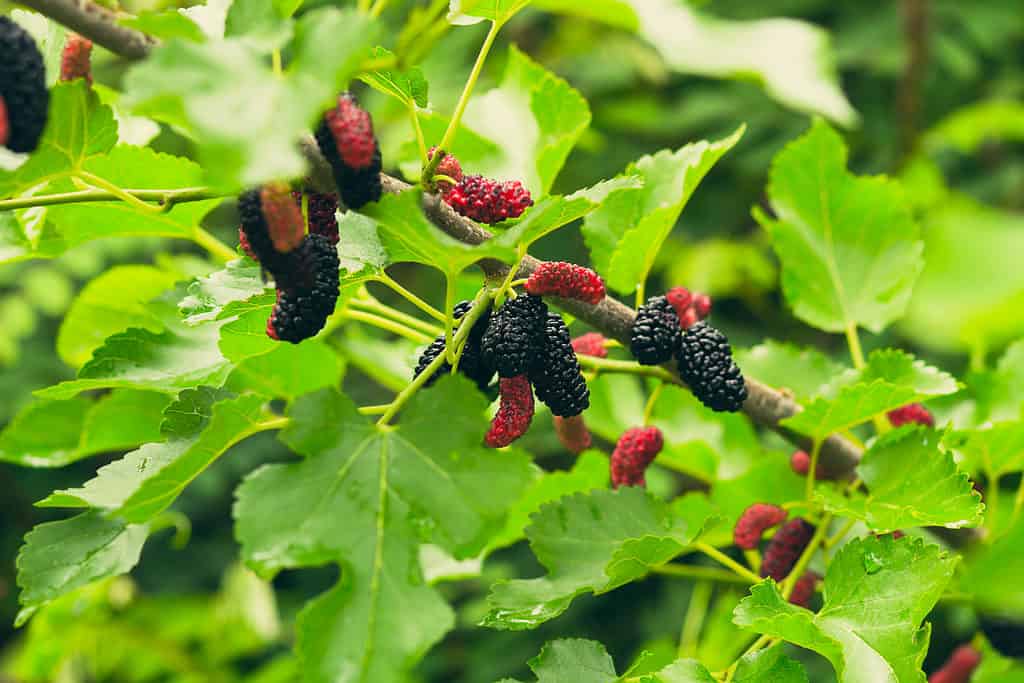
Red mulberry fruit (pictured) is high in vitamins A and C, iron, calcium, and fiber.
©iStock.com/c12
5. Kentucky Coffeetree
The Kentucky coffeetree (Gymnocladus dioicus) is a deciduous tree native to the central and eastern United States, including Kentucky. It typically grows between 50-70 feet tall, with a broad 40-foot canopy that can cast deep shade.
The Kentucky coffeetree has a rugged and gnarled bark that is dark gray or black, reminiscent of well-worn leather. The branches are thick and sturdy, with a slightly upward habit that gives the tree a strong and majestic appearance.
Kentucky coffeetrees are a beautiful and hardy native species that boasts an array of advantages when it comes to planting them in Arkansas. These species have become increasingly popular in the area due to their various features, including their long-lasting leaves, branches, and seeds.
Overall, the Kentucky coffeetree is a versatile and beautiful tree that benefits people and the environment. Its unique appearance, strong and resilient nature, wildlife-friendly, ecological benefits, and aesthetic appeal make it a tree worth loving.

Kentucky coffeetree’s unique appearance, strong and resilient nature, wildlife-friendly, ecological benefits, and aesthetic appeal make it a tree worth loving.
©iStock.com/Inimma-IS
6. Oak Trees
Arkansas is teeming with plant and animal life, but one particular living species stands out among the rest: native oak trees. These majestic and ancient residents of the state’s forests are both beautiful and important.
Native oaks, also known as Quercus genus, are found in many parts of Arkansas, with the greatest concentration in the northwest and north-central areas. These trees are essential to both local ecosystems and the state’s tourism industry, as they serve as a major cultural icon — from logos to images on postcards — for generations of Arkansans.
But what sets these trees apart from other plants? What makes them so valued by locals? To answer these questions, it’s important to understand just what these native oak trees are, why they remain a vital part of Arkansas’ forests, and how their preservation contributes to the state’s ongoing conservation efforts.
Native Arkansas oak trees are incredibly resilient and can survive in various wet and dry conditions. They are also known for their long life spans, with some species living up to 500 years. This makes them an essential part of Arkansas’s natural heritage and a symbol of its history.
Many different species of oak trees are native to Arkansas, such as the White Oak (Quercus alba), Red Oak (Quercus rubra), and Arkansas Oak (Quercus arkansana). Choosing a species that is well-suited to your area’s climate and soil conditions is important. The best time to plant oak trees in Arkansas is in the fall or early spring when the soil is moist, and the weather is cool. This allows the tree to establish roots and start well before the hot summer.
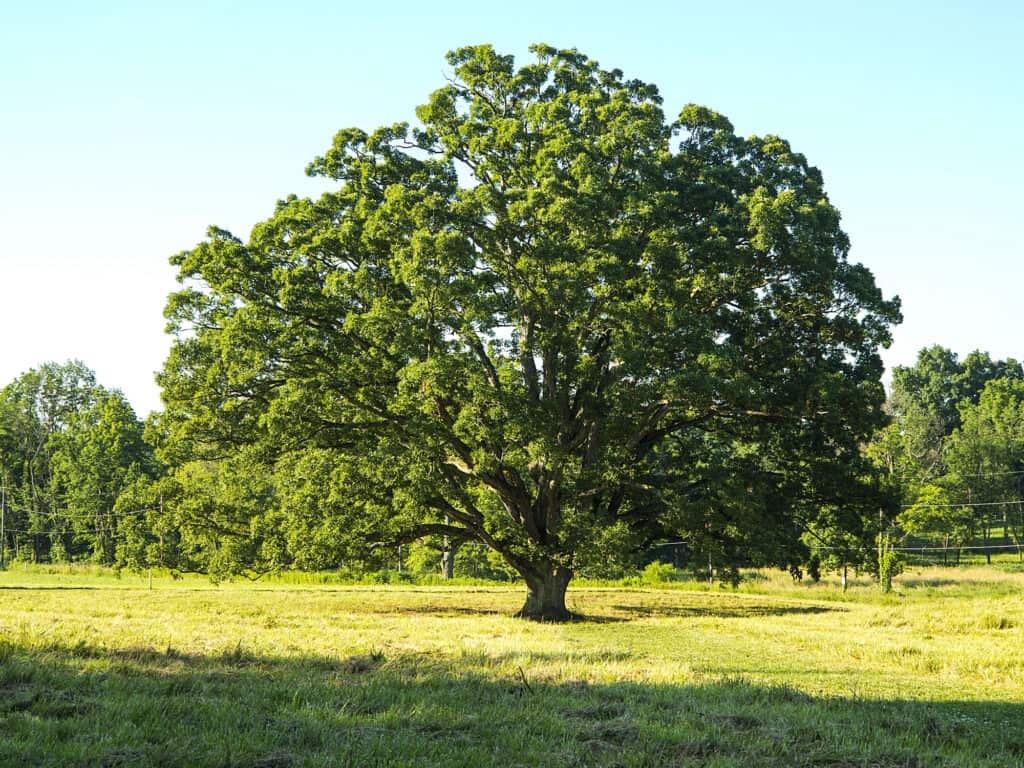
Oak trees (pictured) support insects and feed many animals with acorns, such as squirrels, deer, and opossums.
©iStock.com/Cris Andrei
7. Rusty Blackhaw
The Arkansas rusty blackhaw (Viburnum rufidulum) is a beautiful shrub or tree due to its striking foliage, attractive berries, and overall shape and form. Additionally, it is a small to medium-sized tree that can grow 15-25 feet tall and 8-20 feet wide, making it an excellent option for various landscaping settings.
Rusty blackhaw is a true beauty in the wild. With its unique foliage, stunning berries, and overall shape, this tree will surely capture the hearts of many nature enthusiasts. The leaves are glossy and dark green, making them stand out in the forest canopy. As the seasons change and the temperature cools, the leaves turn a deep red, creating a striking contrast against the blue sky.
In the spring, clusters of small, white flowers bloom, adding yet another layer of beauty to this already mesmerizing tree. Then, as summer approaches, the flowers give way to shiny, black berries that attract birds and other wildlife. Whether you have a small backyard or a large property, the rusty blackhaw tree can be an excellent addition to your landscape.
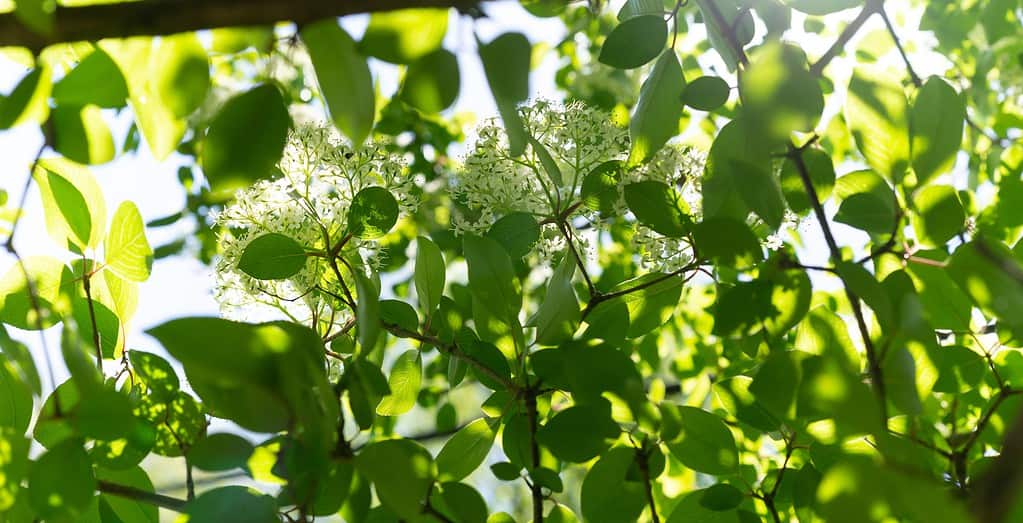
A flowering blackhaw tree in Spring.
©Amy Buxton/Shutterstock.com
Final Thoughts
Arkansas is a beautiful state with a lot to offer, but finding the right plants for your garden can be challenging. The weather is unpredictable, and the soil can be tough on many plants. But some trees can stand up to all that Arkansas has to throw at them.
If you’re looking for a new addition to your garden, you may consider planting some pine or oak trees. Both species have been seen as symbols of strength, endurance, and protection for centuries, and there’s a reason for that. Pine trees are known for their resiliency. They can withstand harsh weather conditions like drought or cold temperatures without suffering damage. Oak trees are strong enough to withstand the force of winds up to 100 miles per hour. And both types provide excellent shade during the summer months.
Trees native to Arkansas provide shade when we’re hot and thirsty and offer a cool place to rest on a hot summer day. We love how they protect us from the elements, keeping us warm in the winter and cold in the summer. We love how they add life to our homes and communities, making them feel alive and vibrant.
Summary Of The 7 Beautiful Trees Native To Arkansas
| Rank | Tree |
|---|---|
| 1 | Pine Tree |
| 2 | Red Buckeye |
| 3 | Eastern Hop-Hornbeam |
| 4 | Red Mulberry |
| 5 | Kentucky Coffeetree |
| 6 | Oak Trees |
| 7 | Rusty Blackhaw |
The photo featured at the top of this post is © iStock.com/Sarah Snydacker
Sources
- Encyclopedia of Arkansas, Available here: https://encyclopediaofarkansas.net/entries/official-state-tree-3139/
- University of Kentucky, Available here: https://www.uky.edu/hort/Red-Buckeye
- NC State Extension, Available here: https://plants.ces.ncsu.edu/plants/ostrya-virginiana/
- Arkansas Department of Agriculture, Available here: https://www.agriculture.arkansas.gov/forestry/champion-trees/red-mulberry-morus-rubra/
- Wikipedia, Available here: https://en.wikipedia.org/wiki/Kentucky_coffeetree
- Arkansas Department of Agriculture, Available here: https://www.agriculture.arkansas.gov/forestry/champion-trees/kentucky-coffeetree-gymnocladus-dioicus/
- Wikipedia, Available here: https://en.wikipedia.org/wiki/Oak
- Wikipedia, Available here: https://en.wikipedia.org/wiki/Quercus_arkansana
- NC State Extension, Available here: https://plants.ces.ncsu.edu/plants/viburnum-rufidulum/
FAQs (Frequently Asked Questions)
What are the most popular trees in Arkansas?
Arkansas has a variety of beautiful native trees, including oak, pine, and red buckeye.
Popular oak trees in Arkansas?
Arkansas’s most common oak trees are white oak, red oak, and chinquapin oak.
Where does Kentucky coffeetree grow?
Kentucky coffeetree is native to many states, including Arkansas, Nebraska, Pennsylvania, and Minnesota.
What are the most common pine trees in Arkansas?
Loblolly pine is the most common tree in the state. They cover a large part of the state and are grown for timber.
Thank you for reading! Have some feedback for us? Contact the AZ Animals editorial team.






